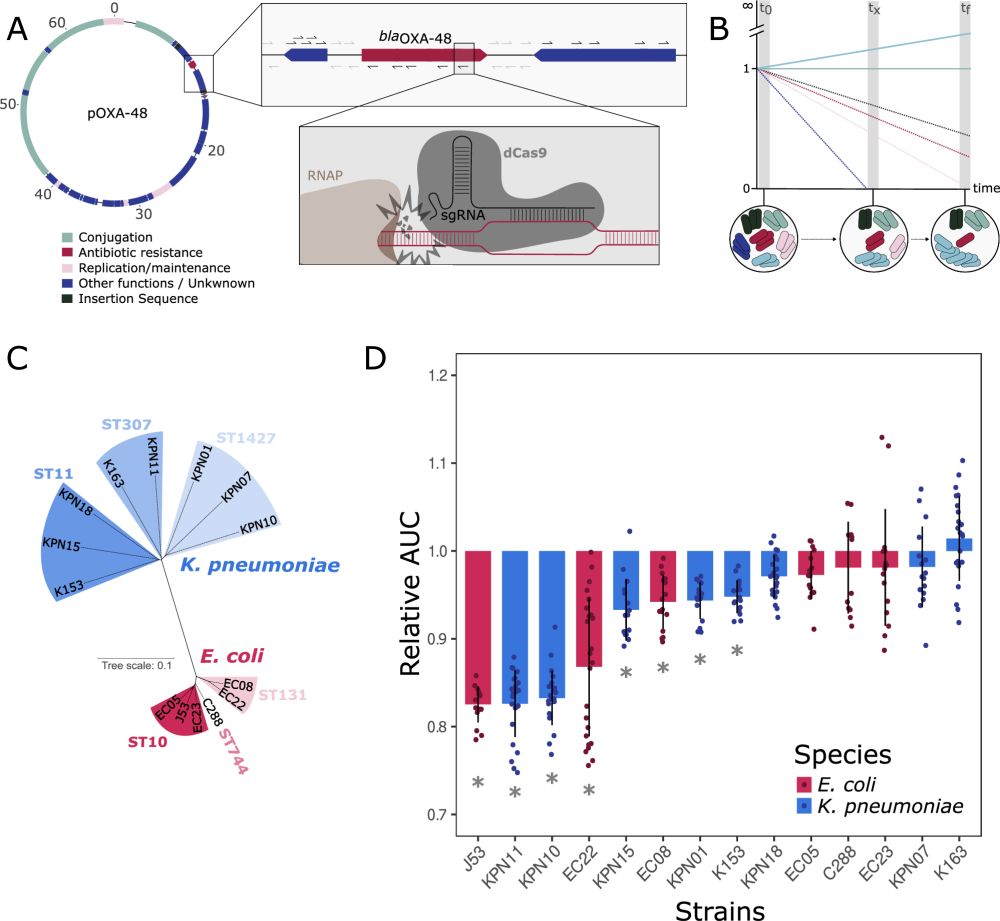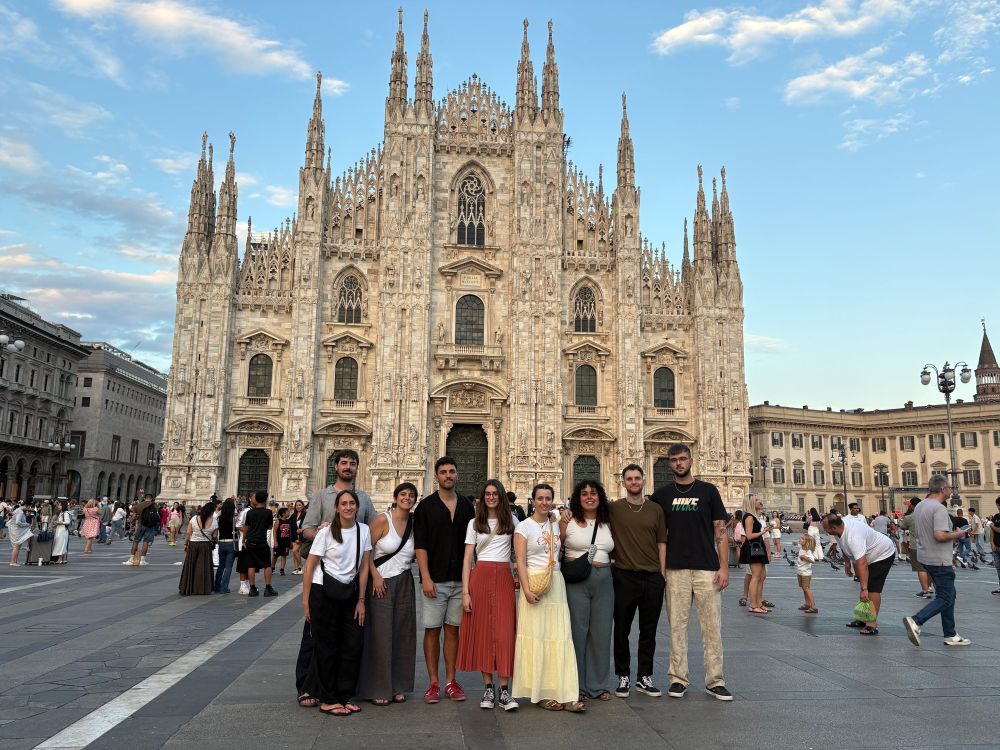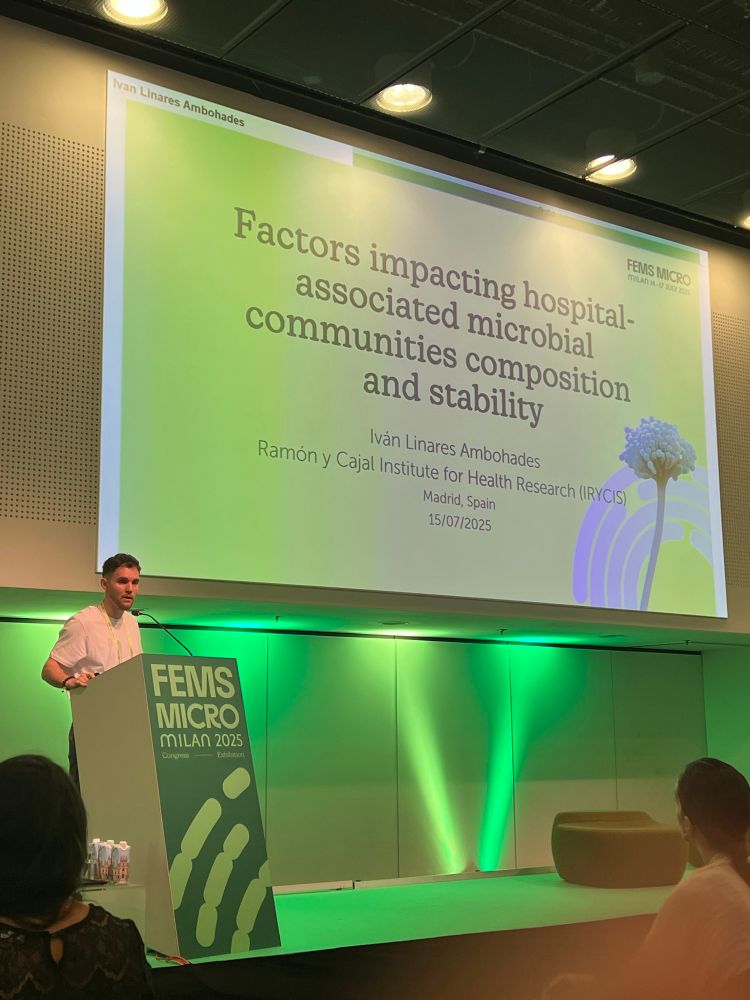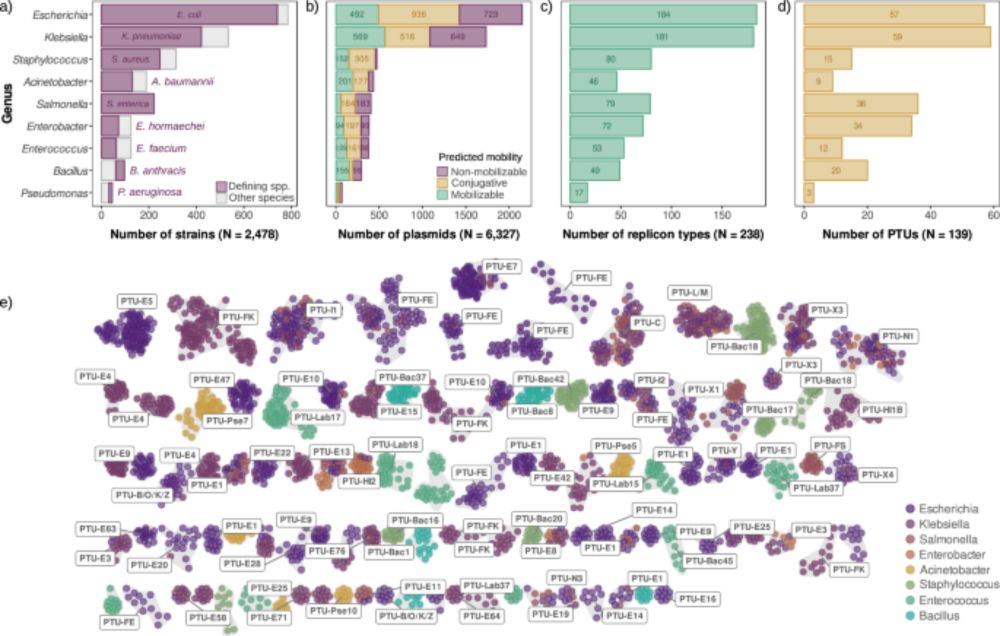
Ana Elena Pérez-Cobas
@anaelenaperezcobas.bsky.social
Microbiologist investigating the respiratory tract microbiome
Pinned

The Respiratory Tract Microbiome and Human Health
The respiratory tract microbiome (RTM) trains the immune system and protects against infections. Changes in the RTM are linked to various respiratory diseases. High-throughput methodologies and compu...
enviromicro-journals.onlinelibrary.wiley.com
New mini-review on the respiratory microbiome and its contribution to human health from biotechnology 🫁🦠
@tmcoque.bsky.social @microbiotech.bsky.social
enviromicro-journals.onlinelibrary.wiley.com/doi/10.1111/...
@tmcoque.bsky.social @microbiotech.bsky.social
enviromicro-journals.onlinelibrary.wiley.com/doi/10.1111/...
Reposted by Ana Elena Pérez-Cobas
Do plasmids really move around that much? Well, maybe not always
Thrilled to have contributed to this story with two of my favourite microbiologists: @jrpenades.bsky.social & @sanmillan.bsky.social
This great work was led by Akshay Sabnis & @wfigueroac3.bsky.social
www.cell.com/cell-reports...
Thrilled to have contributed to this story with two of my favourite microbiologists: @jrpenades.bsky.social & @sanmillan.bsky.social
This great work was led by Akshay Sabnis & @wfigueroac3.bsky.social
www.cell.com/cell-reports...

Non-conjugative plasmids limit their mobility to persist in nature
Sabnis et al. explain why non-conjugative plasmids move at a low rate in nature. While
increased mobility can easily evolve by incorporating phage DNA into plasmids, this
is disadvantageous because it...
www.cell.com
October 22, 2025 at 5:47 PM
Do plasmids really move around that much? Well, maybe not always
Thrilled to have contributed to this story with two of my favourite microbiologists: @jrpenades.bsky.social & @sanmillan.bsky.social
This great work was led by Akshay Sabnis & @wfigueroac3.bsky.social
www.cell.com/cell-reports...
Thrilled to have contributed to this story with two of my favourite microbiologists: @jrpenades.bsky.social & @sanmillan.bsky.social
This great work was led by Akshay Sabnis & @wfigueroac3.bsky.social
www.cell.com/cell-reports...
Reposted by Ana Elena Pérez-Cobas
This work is finally published! 🥳🧬
Plasmids are associated with very variable fitness costs in their different bacterial hosts. But, what is the contribution of each of the plasmid-genes in these host-specific effects? Study led by
@jorgesastred.bsky.social, @sanmillan.bsky.social and myself! 1/14
Plasmids are associated with very variable fitness costs in their different bacterial hosts. But, what is the contribution of each of the plasmid-genes in these host-specific effects? Study led by
@jorgesastred.bsky.social, @sanmillan.bsky.social and myself! 1/14

Dissecting pOXA-48 fitness effects in clinical Enterobacterales using plasmid-wide CRISPRi screens
Nature Communications - This study investigates the effects of the carbapenem resistance plasmid pOXA-48 in clinical enterobacteria. Using CRISPRi screens, the authors revealed that the...
rdcu.be
August 20, 2025 at 1:25 PM
This work is finally published! 🥳🧬
Plasmids are associated with very variable fitness costs in their different bacterial hosts. But, what is the contribution of each of the plasmid-genes in these host-specific effects? Study led by
@jorgesastred.bsky.social, @sanmillan.bsky.social and myself! 1/14
Plasmids are associated with very variable fitness costs in their different bacterial hosts. But, what is the contribution of each of the plasmid-genes in these host-specific effects? Study led by
@jorgesastred.bsky.social, @sanmillan.bsky.social and myself! 1/14
Reposted by Ana Elena Pérez-Cobas
New paper out! 🔈🔈📣📣
Plasmids promote antimicrobial resistance through Insertion Sequence-mediated gene inactivation.
Combining experimental and computational approaches, we unveil how two of the most prevalent bacterial MGE accelerate the evolution of AMR. 🧵👇🏻
www.biorxiv.org/content/10.1...
Plasmids promote antimicrobial resistance through Insertion Sequence-mediated gene inactivation.
Combining experimental and computational approaches, we unveil how two of the most prevalent bacterial MGE accelerate the evolution of AMR. 🧵👇🏻
www.biorxiv.org/content/10.1...

Plasmids promote antimicrobial resistance through Insertion Sequence-mediated gene inactivation
Antimicrobial Resistance (AMR) is a major threat to public health. Plasmids are mobile genetic elements that can rapidly spread across bacterial populations, promoting the dissemination of AMR genes i...
www.biorxiv.org
August 13, 2025 at 6:26 AM
New paper out! 🔈🔈📣📣
Plasmids promote antimicrobial resistance through Insertion Sequence-mediated gene inactivation.
Combining experimental and computational approaches, we unveil how two of the most prevalent bacterial MGE accelerate the evolution of AMR. 🧵👇🏻
www.biorxiv.org/content/10.1...
Plasmids promote antimicrobial resistance through Insertion Sequence-mediated gene inactivation.
Combining experimental and computational approaches, we unveil how two of the most prevalent bacterial MGE accelerate the evolution of AMR. 🧵👇🏻
www.biorxiv.org/content/10.1...
Reposted by Ana Elena Pérez-Cobas
Do plasmids evolve faster 🐇, slower 🐢, or just like chromosomes 🧬?
In our new paper, we tackled this question using theory, simulations, bioinformatics, and experiments!
👇 Check out all the details in Paula’s thread!
Hint: 🐇 (most of the time)
In our new paper, we tackled this question using theory, simulations, bioinformatics, and experiments!
👇 Check out all the details in Paula’s thread!
Hint: 🐇 (most of the time)
July 22, 2025 at 3:05 PM
Do plasmids evolve faster 🐇, slower 🐢, or just like chromosomes 🧬?
In our new paper, we tackled this question using theory, simulations, bioinformatics, and experiments!
👇 Check out all the details in Paula’s thread!
Hint: 🐇 (most of the time)
In our new paper, we tackled this question using theory, simulations, bioinformatics, and experiments!
👇 Check out all the details in Paula’s thread!
Hint: 🐇 (most of the time)
The must-read of this Summer! 🤩 Congrats to all the authors for this beautiful work 🥳
New paper alert! 🚨
Plasmids promote bacterial evolution through a copy number-driven increase in mutation rate.
We combine theory, simulations, experimental evolution, and bioinformatics to demonstrate that mutation rates scale with plasmid copy number.
Let's dive in! 🧵👇
Plasmids promote bacterial evolution through a copy number-driven increase in mutation rate.
We combine theory, simulations, experimental evolution, and bioinformatics to demonstrate that mutation rates scale with plasmid copy number.
Let's dive in! 🧵👇

Plasmids promote bacterial evolution through a copy number-driven increase in mutation rate
Plasmids are autonomously replicating DNA molecules that stably coexist with chromosomes in bacterial cells. These genetic elements drive horizontal gene transfer and play a fundamental role in bacter...
www.biorxiv.org
July 22, 2025 at 10:28 AM
The must-read of this Summer! 🤩 Congrats to all the authors for this beautiful work 🥳
Reposted by Ana Elena Pérez-Cobas
Super proud of the lab for their outstanding presentations at #FEMS2025 in Milano!
Science is better when you work with such a stellar team!🚀✨
@femsmicro.org
Science is better when you work with such a stellar team!🚀✨
@femsmicro.org


July 17, 2025 at 8:21 PM
Super proud of the lab for their outstanding presentations at #FEMS2025 in Milano!
Science is better when you work with such a stellar team!🚀✨
@femsmicro.org
Science is better when you work with such a stellar team!🚀✨
@femsmicro.org
Proud of the talk of Iván Linares at the #FEMS2025 on hospital-associated microbiomes and its role on pathogens persistance 🦠 @femsmicro.org

July 17, 2025 at 3:56 PM
Proud of the talk of Iván Linares at the #FEMS2025 on hospital-associated microbiomes and its role on pathogens persistance 🦠 @femsmicro.org
Congratulations to @cbuch.bsky.social on the FEMS-Lwoff Award!!! Well-deserved ❤️#FEMS2025


July 15, 2025 at 9:51 AM
Congratulations to @cbuch.bsky.social on the FEMS-Lwoff Award!!! Well-deserved ❤️#FEMS2025
Reposted by Ana Elena Pérez-Cobas
🚨🚨New paper out in @natcomms.nature.com!!
Come for the first large-scale analysis of plasmid copy number across species,
stay for one of the most intriguing results of my lab: universal scaling laws in plasmid biology! 📈🧬
👉 www.nature.com/articles/s41...
Come for the first large-scale analysis of plasmid copy number across species,
stay for one of the most intriguing results of my lab: universal scaling laws in plasmid biology! 📈🧬
👉 www.nature.com/articles/s41...

Universal rules govern plasmid copy number - Nature Communications
Plasmids exhibit a broad range of sizes and copies per cell, and these two parameters appear to be negatively correlated. Here, Ramiro-Martínez et al. analyse the copy number of thousands of diverse b...
www.nature.com
July 2, 2025 at 11:08 AM
🚨🚨New paper out in @natcomms.nature.com!!
Come for the first large-scale analysis of plasmid copy number across species,
stay for one of the most intriguing results of my lab: universal scaling laws in plasmid biology! 📈🧬
👉 www.nature.com/articles/s41...
Come for the first large-scale analysis of plasmid copy number across species,
stay for one of the most intriguing results of my lab: universal scaling laws in plasmid biology! 📈🧬
👉 www.nature.com/articles/s41...
Reposted by Ana Elena Pérez-Cobas
🧪
Finally out after peer review, our work showing that "Mobile #Integrons carry Phage Defense Systems" is now published in Science 🎉
Short 🧵
www.science.org/doi/10.1126/...
Finally out after peer review, our work showing that "Mobile #Integrons carry Phage Defense Systems" is now published in Science 🎉
Short 🧵
www.science.org/doi/10.1126/...

Mobile integrons encode phage defense systems
Integrons are bacterial genetic elements that capture, stockpile, and modulate the expression of genes encoded in integron cassettes. Mobile integrons (MIs) are borne on plasmids, acting as a vehicle ...
www.science.org
May 8, 2025 at 8:27 PM
🧪
Finally out after peer review, our work showing that "Mobile #Integrons carry Phage Defense Systems" is now published in Science 🎉
Short 🧵
www.science.org/doi/10.1126/...
Finally out after peer review, our work showing that "Mobile #Integrons carry Phage Defense Systems" is now published in Science 🎉
Short 🧵
www.science.org/doi/10.1126/...
New mini-review on the respiratory microbiome and its contribution to human health from biotechnology 🫁🦠
@tmcoque.bsky.social @microbiotech.bsky.social
enviromicro-journals.onlinelibrary.wiley.com/doi/10.1111/...
@tmcoque.bsky.social @microbiotech.bsky.social
enviromicro-journals.onlinelibrary.wiley.com/doi/10.1111/...

The Respiratory Tract Microbiome and Human Health
The respiratory tract microbiome (RTM) trains the immune system and protects against infections. Changes in the RTM are linked to various respiratory diseases. High-throughput methodologies and compu...
enviromicro-journals.onlinelibrary.wiley.com
April 29, 2025 at 3:33 PM
New mini-review on the respiratory microbiome and its contribution to human health from biotechnology 🫁🦠
@tmcoque.bsky.social @microbiotech.bsky.social
enviromicro-journals.onlinelibrary.wiley.com/doi/10.1111/...
@tmcoque.bsky.social @microbiotech.bsky.social
enviromicro-journals.onlinelibrary.wiley.com/doi/10.1111/...
Reposted by Ana Elena Pérez-Cobas
New preprint from the lab!! Check it out!
🚨 New preprint! We know that plasmids are associated with very variable fitness costs in their different bacterial hosts. But, what is the contribution of each of the plasmid-genes in these host-specific effects? Study led by @jorgesastred.bsky.social, @sanmillan.bsky.social and myself! 1/14

Dissecting pOXA-48 fitness effects in clinical enterobacteria using plasmid-wide CRISPRi screens
Conjugative plasmids are the main vehicle for the spread of antimicrobial resistance (AMR) genes in clinical bacteria. AMR plasmids allow bacteria to survive antibiotic treatments, but they also produ...
www.biorxiv.org
January 24, 2025 at 12:49 PM
New preprint from the lab!! Check it out!
Delighted to have contributed to this fascinating paper led by Prof. Timmis on how helpful microbes can be for humanity at different scales! "The future is not set. There is no fate but what we make for ourselves". -John Connor (Terminator)
@microbiotech.bsky.social
@microbiotech.bsky.social
A large group of leading international microbiologists headed by Ken Timmis has just published a report/manifesto on how microorganism can be our best allies for building a better human future—a ray of hope precisely these days 👏 enviromicro-journals.onlinelibrary.wiley.com/doi/full/10....

Microbes Saving Lives and Reducing Suffering
Click on the article title to read more.
enviromicro-journals.onlinelibrary.wiley.com
January 24, 2025 at 10:57 AM
Delighted to have contributed to this fascinating paper led by Prof. Timmis on how helpful microbes can be for humanity at different scales! "The future is not set. There is no fate but what we make for ourselves". -John Connor (Terminator)
@microbiotech.bsky.social
@microbiotech.bsky.social

